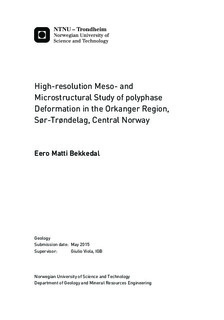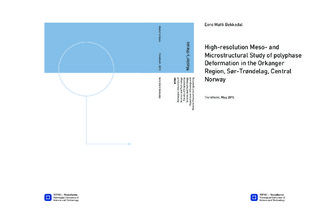| dc.description.abstract | The Orkanger Road Cut (ORC) is a 300 m long section of exposed country rock that has preserved an important record of structures linked to the tectonic history of the Mid-Western Gneiss Region. High-resolution field mapping conducted on all structures, combined with microscopical analysis of thin sections is presented in a systematic meso- and micro-scale evaluation. A highly detailed cross section of the ORC has been produced as a key guide to the position and orientation of the structures and to ease the work of combining and separating complex structures from heavy overprinting. The structures of the ORC show cutting relationships yielding a relative age for each type of structure. The described structures of the ORC display very consistent trends for pegmatites, folds, high strain zones, ductile shear zones and brittle faults. A ductile thrust may be a part of the roof-contact of an extrusion wedge in the Jämtland-Västerbotten area of Sweden. Crosscutting relationships have yielded a relative age to the structures of the ORC listed from the oldest to the youngest: high strain zones, generation 1 pegmatite intrusion, F1 folding, generation 2 pegmatites, F2 folding, generation 3 pegmatites, ductile shear zones, brittle-ductile faults and finally brittle faulting.
Three types of relict structures are especially prone to reactivation within the Orkanger Road Cut. These include pegmatites, ductile shear zones and folds, which show reactivation along different types of contacts. A model based on these observations was made to explain the evolution of these brittle reactivations. A paleostress analysis of the brittle faults in the ORC produced three different stress fields, which of two can be regarded as paleostress fields based on the orientation of the fault planes and their mineral coating. These stress fields include: 1. a fault group yielding NE-SW dip-slip extension with quartz coating, interpreted to be a paleostress field 2. a fault group showing NW-SE oblique slip extension with epidote, which also is regarded as a paleo stress field, 3. NE-SW compression related to neo-tectonics. Structures at the ORC show a close connection between structures found within the ORC and the complex tectonic history of the region, dominated by the MTFC. The structures observed at the ORC can be linked to both the compressional and extensional phase of the orogenic evolution of the Caledonides. | |

